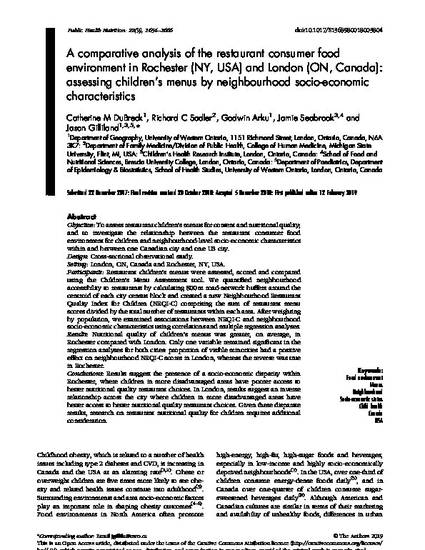
Objective:To assess restaurant children’s menus for content and nutritional quality; and to investigate the relationship between the restaurant consumer food environment for children and neighbourhood-level socio-economic characteristics within and between one Canadian city and one US city. Design: Cross-sectional observational study. Setting: London, ON, Canada and Rochester, NY, USA. Participants: Restaurant children’s menus were assessed, scored and compared using the Children’s Menu Assessment tool. We quantified neighbourhood accessibility to restaurants by calculating 800 m road-network buffers around the centroid of each city census block and created a new Neighbourhood Restaurant Quality Index for Children (NRQI-C) comprising the sum of restaurant menu scores divided by the total number of restaurants within each area. After weighting by population, we examined associations between NRQI-C and neighbourhood socio-economic characteristics using correlations and multiple regression analyses. Results: Nutritional quality of children’s menus was greater, on average, in Rochester compared with London. Only one variable remained significant in the regression analyses for both cities: proportion of visible minorities had a positive effect on neighbourhood NRQI-C scores in London, whereas the reverse was true in Rochester. Conclusions: Results suggest the presence of a socio-economic disparity within Rochester, where children in more disadvantaged areas have poorer access to better nutritional quality restaurant choices. In London, results suggest an inverse relationship across the city where children in more disadvantaged areas have better access to better nutritional quality restaurant choices. Given these disparate results, research on restaurant nutritional quality for children requires additional consideration.

Also available open access in Public Health Nutrition at: https://doi.org/10.1017/S1368980018003804